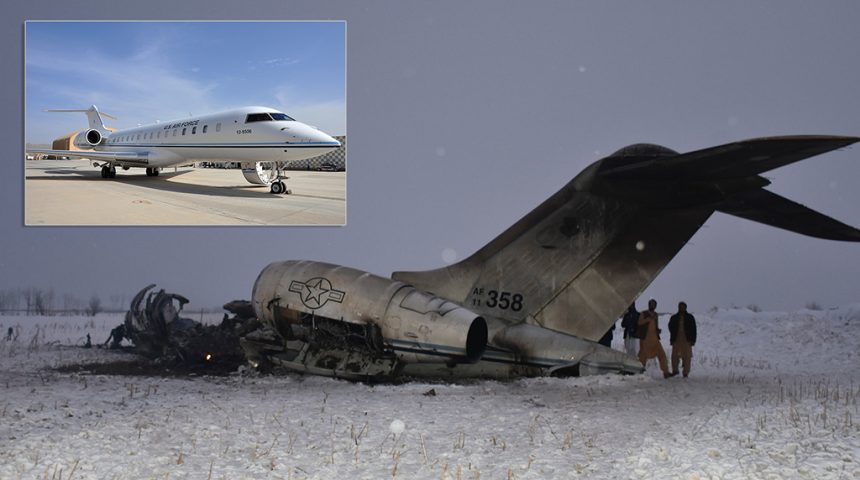Fatal USAF E-11A crash caused by engine failure and subsequent aircrew mistake.
On Jan. 27, 2020, a U.S. Air Force’s E-11A, serial 11-9358, crash landed in a field in Ghanzi Province, Afghanistan. The aircraft was one of the four E-11A (Bombardier Global 6000 advanced ultra long-range business jets modified by the U.S. Air Force to accommodate Battlefield Airborne Communications Node payload) assigned to the 430th Expeditionary Electronic Combat Squadron, 455th Air Expeditionary Wing, operating out of Kandahar Airfield (KAF).
The BACN system is used as a “flying gateway” to allow datalink communication between different platforms and to link ground troops and Forward Air Controllers (FACs)/Joint Terminal Attack Controllers in a non-line-of-sight (LOS) environment. For instance, in the rugged, mountainous terrain of Afghanistan, troops are not always able to establish LOS communications with close support aircraft overhead. Moving position or relocating to higher ground could be fatal in a combat situation. The BACN has the capability to relay voice, video, imagery and data between warfighters in the air and on the ground, 24 hours a day and seven days a week. All U.S. Air Force E-11As are assigned to the 430th Expeditionary Electronic Combat Squadron and operate solely out
of KAF.
As you will probably remember, photos and videos of the BACN (Battlefield Airborne Communications Node) showing a burned up cockpit and fuselage almost immediately emerged on social media. Both pilots aboard the aircraft were killed in the crash.
VIDEO:
We have a clear footage now of the crashed plane. #Ghazni #Afghanistan pic.twitter.com/onlMjFiOma
— FJ (@Natsecjeff) January 27, 2020
The U.S. Air Force has completed the investigation into the mishap and found the root cause of the incident in the human factor.
“At 1105L, the MA [Mishap Aircraft] departed KAF. The mission proceeded uneventfully until the left engine catastrophically failed one hour and 45 minutes into the flight (1250:52L)” says the Aircraft Accident Investigation Board Report. “Specifically, a fan blade broke free causing the left engine to shutdown. The MC improperly assessed that the operable right engine had failed and initiated shutdown of the right engine leading to a dual engine out emergency. Subsequently, the MC attempted to fly the MA back to KAF, approximately 230 nautical miles (NM) away. Unfortunately, the MC [Mishap Crew] were unable to get either engine airstarted to provide any usable thrust. This resulted in the MA unable to glide the distance remaining to KAF.”
“With few options remaining, the MC maneuvered the MA towards Forward Operating Base (FOB) Sharana, but did not have the altitude and airspeed to glide the remaining distance. The MC unsuccessfully attempted landing in a field approximately 21 NM short of FOB Sharana.”
“The Accident Investigation Board (AIB) President found by a preponderance of the evidence that the cause of the mishap was the MC’s error in analyzing which engine had catastrophically failed (left engine). This error resulted in the MC’s decision to shutdown the operable right engine creating a dual engine out emergency. The AIB President also found by a preponderance of the evidence that the MC’s failure to airstart the right engine and their decision to recover the MA to KAF substantially contributed to the mishap.”
In other words, 24 seconds after a catastrophic failure of the left engine (fan blade separation), the pilots initiated a right engine shutdown, failing to recognize which engine had suffered the issue. This was probably due to the loud bang and severe vibrations that accompany the first moments following blade separation, as experienced by a pilot in a Global Express aircraft (civilian equivalent to the E-11A) that suffered the same kind of emergency in 2006. During that event, the pilot in command stated that he could not determine which engine had failed based on aircraft vibration and sensation alone without looking at the instruments. His crew took 1-2 minutes to shut down the left engine and this is the reason why the Accident Board says in the report that the E-11A probably did not spend sufficient time to properly analyze the situation.
“At the point of the dual engine out emergency, the MA’s position was approximately 38 nautical miles (NM) from Bagram Airfield, 17 NM from Kabul International Airport, 28 NM from Forward Operating Base (FOB) Shank, and 230 NM from KAF. Each location, with the exception of an intermediate cloud layer, had observed ceilings and visibility at or above 2,000 feet altitude above the ground and three NM respectively. Otherwise, there was no significant weather and therefore, the weather would have permitted for a safe landing. However, the MC attempted to fly the MA back to KAF as evidenced by the following MC initiated radio call to Kabul Air Traffic Control (ATC) at 1254:55L: “…Mayday, Mayday, Mayday…it looks like we have an engine failure on both motors, we are proceeding direct to Kandahar at this time…”
“Evidence shows that neither engine airstarted to provide any usable thrust. This resulted in the MA unable to glide the distance remaining to KAF. Additionally, the MA eventually flew outside of gliding distance to Bagram Airfield, Kabul International Airport, and FOB Shank, demonstrated through flight simulator profiles. With few options remaining, the MC maneuvered the MA towards FOB Sharana, but did not have the altitude and airspeed to glide the distance remaining. The MC attempted landing in a field approximately 21 NM short of the Sharana FOB, but the MA was significantly damaged upon touchdown, coming to rest approximately 340 meters from the touchdown point.”
Therefore, as in most aviation incidents, a series of factors (initiated by a failure that would not, alone, cause a crash), contributed to the loss of the E-11A and the death of two pilots.









